With an estimated population of 24 million, and counting, Manu Shrivastav sketches the picture of a throbbing, pulsating and quintessential Mumbai that has taken in its flexible and resilient fold myriad communities, cultures, customs and practices. Always on the move, the bustling metropolis is a ‘City of Dreams’ has bread and butter for everyone who wants to eke out a living.
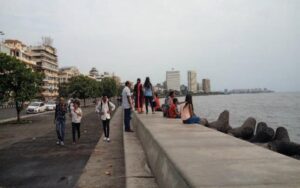 Marine Drive — A favourite place of Mumbaikars, who are regularly seen taking brisk walks, doing yoga or simply enjoying the beauty of the Arabian Sea against Mumbai’s skyline.
Marine Drive — A favourite place of Mumbaikars, who are regularly seen taking brisk walks, doing yoga or simply enjoying the beauty of the Arabian Sea against Mumbai’s skyline.
Mumbai is one of the most vibrant cities of India and the world. Tourists come from across borders to witness the teeming ‘city of dreams’ in its full colour and richness. It won’t be wrong to say that the people of Mumbai are its biggest asset even one of the most popular items in the visitors’ to-do list when they visit Mumbai. The city is a potpourri of people belonging to different communities, ethnic groups, cultures, tribes and pursuing diverse vocations and professions.
Today, the megapolis has an estimated population of more than 24 million people that give Mumbai the unique flavour like none other in the world. Mumbaikars, as Mumbai’s people are popularly known, are hardworking and fun-loving people who make the most of ‘space’ that is the most precious commodity in the city. Mumbai is also one of the most expensive places in the world to live in.
Mumbai is the centre of the Mumbai Metropolitan Region (MMR) which happens to be the sixth most populous metropolitan area in the world. With its strategic existence on the Konkan coast, peninsular Mumbai is a deep natural harbour which is why it was one of the most coveted ports for the different rulers and colonists that reigned the region.
Mumbai is home to the highest number of millionaires and billionaires among all the cities in India. Mumbai is also home to several UNESCO World Heritage Sites including the cluster of Victorian and Art Deco buildings in the Fort precinct and Marine Drive, Elephanta Caves and the Chhatrapati Shivaji Maharaj Terminus. Now, Maharashtra has more UNESCO World Heritage Sites than any other state in the country – a total of five sites including the Ajanta and Ellora caves in Aurangabad.
As the country’s financial and entertainment capital, Mumbai also has the highest number of migrants that add a unique tinge to the vibrant city. The city is home to the Maharashtrians, Gujaratis, Konkanis, Parsis, Muslims, Christians, Hindus, Jews, Jains, Buddhists, etc. The interplay of diverse cultures and communities is what renders Mumbai its unique existence.
The diverse works of Mumbai’s people
With an area of just over two sq km and a whopping population of more than 10,00,000 people, Dharavi is one of the most densely-populated slums in Mumbai and also a melting pot of diverse cultures, religions and ethnicities. Dharavi and its people are not new to fame as several Bollywood films have been based in Dharavi, particularly its people, their lifestyle and theirstories.
Founded in the 19 th century, Dharavi gradually became a hub of factories and small-scale industries that today deploy thousands of people. The small-scale industry and household enterprises or the cottage industries are a big contributor to the informal economy that exists in Dharavi and employs a significant population of the slum and churn out a formidable turnover. Popular industries in Dharavi are leather, pottery products, textiles, etc.
The Kumbharwada area in Dharavi, for example, is home to the thousands of potters, mainly Gujarati-speaking artisans who came from Saurashtra in Gujarat to expand their business. The potters or the kumbhars (potters) live and work in the area. The kumbhars can be spotted from far as they sit surrounded by hundred of pottery products.
There are several other groups of people, in Mumbai, that have been an anchor of Mumbai’s fast-paced life. From the quintessential cobbler who sits at every nook and corner of the city’s street polishing shoes of the officer-goers, repairing them to ensure the pace of the city and its workers doesn’t slow down
to the mechanics who fix broken down vehicles.
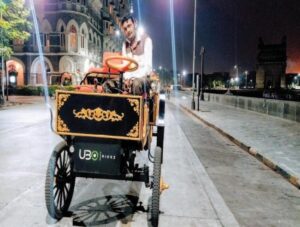 The new carriages that carry tourists in Mumbai
The new carriages that carry tourists in Mumbai
And, the old-time Mumbaikar cannot forget the now-rarely- seen plastic repairmen who would fix broken or cracked plastic buckets, water containers, water tanks, etc. and sometimes even fix footwear, etc. For most people in Mumbai especially those living in the slums, filling and storing water is a necessity and the plastic repairman is their saviour. Although they’re now fast getting extinct, they can still be seen in the older neighbourhoods of the city
The street performers of Mumbai
For the longest time, songs in Hindi-language films have featured the many street performers that add colour and vibrance to the streets of Mumbai. Be it the little girl balancing her way on the tight-rope walk with her mother playing drums next to the stilt on which the rope is tied, or the madari who performs magic in front of a spellbound crowd gathered around him.
The street performers of Mumbai are a unique lot and also a strong thread in the multi-cultural fabric of the city. The Gaiwalas, also known as the gugububuwalas or nandi bailwalas, are a nomadic group of people who come to Mumbai on foot from far-off places in the interiors of Maharashtra. These families walk to Mumbai, stay in the city for a few months, going from one area to another collecting alms and money from the people who believe their cows are auspicious.
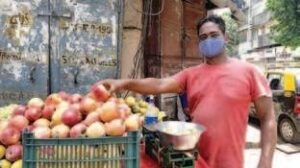 A fruit vendor selling apples on the streets
A fruit vendor selling apples on the streets
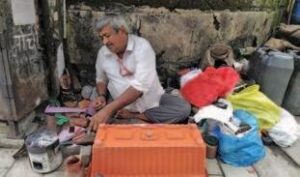 A plastic repair man fixing platic items
A plastic repair man fixing platic items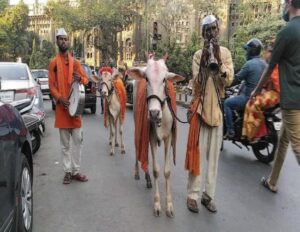 Gaiwalas or Nandibailwalas; a nomadic tribe who roam the streets of Mumbai collecting alms from people who believe that their cows/bulls are auspicious
Gaiwalas or Nandibailwalas; a nomadic tribe who roam the streets of Mumbai collecting alms from people who believe that their cows/bulls are auspicious
 A chabukwalla (member of Potraj community) performing
A chabukwalla (member of Potraj community) performing
on the streets of Mumbai
These cows/bulls are part of their family and are considered holy owing to the presence of an extra limb or a hump. The devout believe that these cows possess magicalqualities to heal and predict the future.
So, the male members of this tribal community mostly walk around the streets of Mumbai, going from one neighbourhood to another, with an ‘auspicious’ nandibail or a bull. When they pass by, the believers stop by to donate food or money or clothing. Interestingly, the women of this nomadic community do not walk the streets but sit outside temples with a female cow. The devotees visiting the temple often feed the cow or give money to the women as a mark of their devotion.
Another regular sight on the streets of Mumbai are members of the Potraj community also known as the Chabukwalas. These too are street performers and a nomadic group like the Gugububuwalas. This community also often moves in a pair, husband and wife and more often than not the woman has a child wrapped around her body through a cloth sling.
The Chabukwala wears ghungrus and carries a heavy whip with which it hits itself in a typical manner that makes a loud whipping sound. The woman plays a drum and often carries an idol of ‘Khada Laxmi’ on her head. It’s the loud sound of whipping that draws people to the act who then give money to the performing couple for their performance.
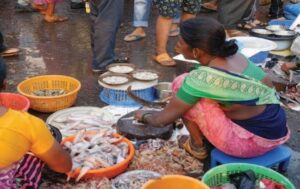 A Koli woman selling fish at a local fish market in Mumbai
A Koli woman selling fish at a local fish market in Mumbai
The diverse communities of Mumbai
Another indigenous group that is often spotted on the streets of Mumbai is the Pardhi community. A Denotified Tribe (DNT), the Pardhis today are relegated to selling wares at tourist destinations in Mumbai such as the Gateway of India, Chowpatty, etc. Most Pardhi families have several children who often run behind tourists asking for money or food. Nevertheless, the Pardhis form an indispensable part of Mumbai and the lives of its people.
The native people of Mumbai, the Kolis are the original inhabitants of the group of islands that form present-day Mumbai. The Koli community has been living and working along the coasts of these islands for centuries. There are several areas in Mumbai where their population is significant and these include Worli, Colaba, Dongri, Sion, Vasai, etc. The areas where the Koli population is predominant is often called a Koliwada.
At present, more than five lakh Kolis are estimated to be living in Mumbai and in the neighbouring areas. A Koli woman is easily identifiable by the way she is dressed up and the ornaments she adorns. The Koli women form a common sight at fish markets across Mumbai including Sassoon Docks, Worli, Mazgaon, etc.
The Kolis have played an important role in the development of the area especially the coastlines. It is interesting to note that several islands were named by the Kolis including Kolbhat (now Colaba), Palva Bunder (now Apollo Bunder), Dongri, Mazgaon, Naigaum and Worli. The name ‘Mumbai’ also owes its origin to the Mumbadevi Temple, located in Dongri. The goddess Mumba is the patron goddess of the Kolis and the Agris – the original inhabitants of the seven islands of Mumbai. The Agris were the native salt collectors while the Kolis were the fishermen.
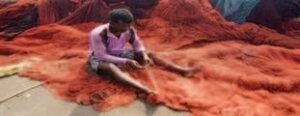 A fisherman fixing his fishing net at a dock in Mumbai
A fisherman fixing his fishing net at a dock in Mumbai
 A cobbler sitting on a pavement polishing a shoe
A cobbler sitting on a pavement polishing a shoe
Tourist destinations and the people
Mumbai is one of the most popular tourist destinations in the world. Tourists across the world come to Mumbai to experience the pace of the city, the cultural potpourri, the diversity of its people, the markets, shopping avenues, architectural marvels, historical landmarks, etc. Mumbai`s history is not just rich but also very interesting as the city has the impressions of several dynasties, rulers and leaders.
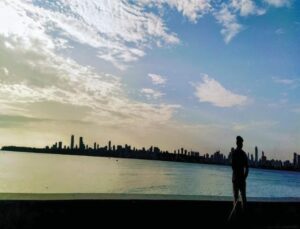 Police holding guard during the lockdown in Mumbai at Marine Drive
Police holding guard during the lockdown in Mumbai at Marine Drive
So, tourist destinations in Mumbai are microcosms in themselves. Each such place will have a certain kind of people that form the character of the place. At Gateway of India, for example, photographers have been an essential part of the experience there for decades.
Gateway photographers, dressed in white shirts and black trousers, carrying their cameras around the neck, are seen asking visitors if they would want their picture clicked against the Gateway of India, the Taj Mahal Palace hotel, etc. The most popular pose being when the excited tourist pretends to hold the top of the iconic structure or the hotel.
At this location, Pardhis are visible selling wares, jewellery, gadgets and accessories, etc. Similar sight is at Chowpatty or Girgaum Chowpatty, the original Chowpatty of Mumbai. Thousands of Mumbaikars and tourists throng the beach and the adjoining Marine Drive at mornings and evenings. At Chowpatty, families can be seen picnicking at the beach with their children playing with sand and sometimes in the shallow waters.
Marine Drive is often occupied by walkers in mornings and evenings taking brisk walks, doing yoga and pranayam or simply enjoying the beauty of the sea against Mumbai’s skyline. During the day, couples sit on the wall facing the sea and oblivious to the world. Hawkers sell sing, chana, tea, etc., and homegrown masseuses walk the promenade calling out for people to get a nice, relaxing foot rub and massage.
Mumbai police personnel also form an important part of life in Mumbai. Many Bollywood films have featured police personnel sometimes as part of a dance number, other times as running behind offenders even shooing couples away. At Marine Drive and Nariman Point, police personnel are seen patrolling the promenade on two-wheeled personal transporters and keeping a vigil eye on the city.
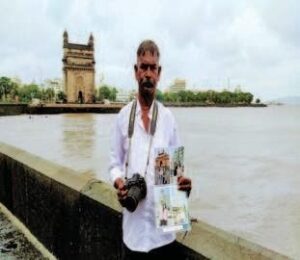 A photographer at the Gateway of India promenade
A photographer at the Gateway of India promenade
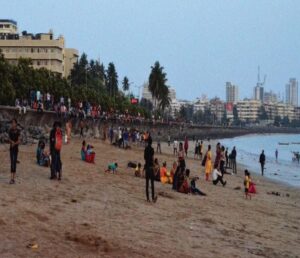 Mumbaikars enjoying a day at Chowpatty
Mumbaikars enjoying a day at Chowpatty
The diverse religious groups
Mumbai is home to many communities from across religions but the ones that have garnered the most interest are the Catholics and the Parsis among others. The Parsis are a group of people who follow Zoroastrianism. Their ancestors had fled from Persia (Iran) in the seventh century CE following the Muslim conquest of Persia and had sought refuge in Gujarat.
Parsis form one of the two groups of people from Persia who live in India and particularly in Mumbai. The other ones are the Iranis who migrated to India many centuries later. Today, the largest Parsi population happens to be in Mumbai. The Parsis of Mumbai are an influential community and some of the biggest industrial groups are owned by the Parsis, the most prominent being the Tata Group.
Several landmarks in Mumbai are named after famous Parsi people including Nariman Point. The Iranis, on the other hand, are known for their Irani cafes across Mumbai. For example, Yazdani bakery located in a bylane near Flora Fountain has been serving Mumbaikars with delicious bun maska, Irani chai and other freshly-baked items for decades. Many Iranis in Mumbai are also part of the film and television industry and have created a niche for themselves.
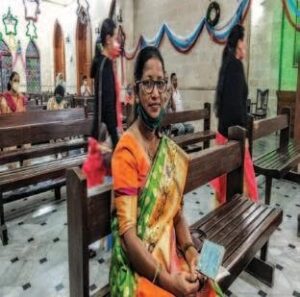 A devout at a church in Mumbai
A devout at a church in Mumbai
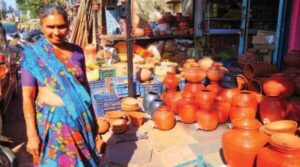 A woman selling earthen pots in Dharavi’s Kumbharwada
A woman selling earthen pots in Dharavi’s Kumbharwada
The other group of people that form an important part of Mumbai’s cultural heritage are members of the Catholic and Christian community. The Roman Catholic Archdiocese whose seat is in Maharashtra is the Roman Catholic Archdiocese of Bombay. The East Indians that are predominantly Roman
Catholic and the predominantly Protestant Marathi Christians form the major part of their population.
The Catholics in Mumbai and Maharashtra at large including the coastal regions of Vasai, Raigad, etc., are the East Indians and were evangelized by the Portuguese missionaries during 15 th and 16 th centuries. Khotachiwadi, a small heritage enclave in Girgaon in Mumbai, is home to several East Indian families. The area has a distinct character with old-Portuguese style architecture. The beautiful churches in Mumbai are thronged by these communities on Sundays, during Christmas, Easter and other Christian holidays.
Another interesting community living in Mumbai is the Jewish community. The history of the Jews in Mumbai began when they started settling in ‘Bombay’ during the first century.
Mumbai was the hub of economic activity and key to many economic opportunities. The primary groups of the Jewish community in Mumbai comprise the Bene Israeli Jews of Konkan, the Baghdadi Jews of Iraq and the Cochin Jews of Malabar.
Today, there are very few Jews left in the city as many have migrated to the West or back to Israel. Many structures and landmarks in Mumbai such as the Sassoon Docks, David Sassoon Library, Chabad House, etc., are a reminder of the Jewish heritage of Mumbai.
Manu Shrivastava
Manu Shrivastava is a journalist and lawyer with DraftCraft International and Co-Convenor of #TheWomanSurvivor, #MeTooAtHome and #MeTooBeyondBorders initiatives. [/column]


